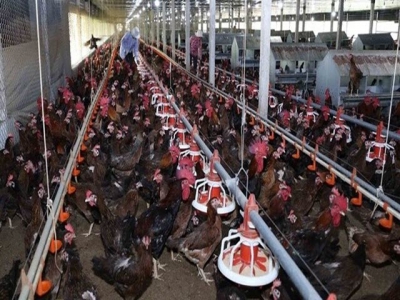Vietnam promotes export of poultry products

According to the Vietnam Poultry Association, over the past years, the poultry industry has made rapid progress. As of the end of 2018, the poultry flock saw rapid growth, numbering over 409 million. The export value of poultry products was estimated at over US$40 million.
A poultry farm in the central province of Binh Dinh. (Photo: VNA)
Deputy Director of the Department of Livestock Husbandry Nguyen Van Trong said the poultry industry has been shifting from small to large scale, with rising productivity and product quality. The total poultry flock is increasing by an average 6% a year, with annual output reaching more than 1 million tonnes of meat and more than 11 billion eggs at present.
Vietnam has exported between 10-15 million salted duck eggs each year, and began to ship abroad processed chicken in September 2017, with nearly 8,000 tonnes in exports in 2018. The country also exports several poultry products such as canned quail eggs, braised black chicken, and egg powder.
Many technological advances have been applied to production to improve the quality and competitiveness of the poultry industry. In addition, large-scale poultry farming with modern technology has seen development. Many domestic and foreign enterprises continue to invest in large-scale production with advanced industrial methods and hi-tech applications. There are more and more production facilities with a scale from 300,000 to 500,000 broilers.
Vietnam also possesses a variety of poultry breeds, including super meat, super egg, and dual-purpose poultry breeds, imported poultry breeds, and new breeds such as Dong Tao chicken in Hung Yen province, Son Tay chicken in Hanoi, Tien Yen chicken in Quang Ninh province, and Ninh Hoa chicken, along with high-quality duck breeds imported from the UK and France.
However, there was an imbalance between supply and demand with small scale farms facing high production costs and risk of disease. Another problem facing the poultry sector is the poor quality of breeding stock, and a lack of linkage between farming, slaughtering and processing in the production chain.
Localities should draw up support policies for farmers, owners and enterprises to invest in poultry development. It was also necessary to focus on production to meet quality standards both at home and abroad. This would create favourable conditions for domestic poultry products to meet hygiene and safety standards in export markets such as Japan, the Republic of Korea (RoK) and some ASEAN countries.
The industry will also need a strategy to increase other processed poultry products, including processed chicken and duck and other products processed from eggs.
Some experts recommended several suitable markets for Vietnam’s poultry meat products, such as Japan, China and the Philippines, based on existing favourable conditions such as free trade agreements and close distance. Meanwhile, egg export should target Northeast Asian and Southeast Asian countries.
In order to boost exports, the industry should build safe areas free from disease and have mechanisms to protect poultry farms, ensuring the quality standards of export markets.
Có thể bạn quan tâm
Phần mềm

Phối trộn thức ăn chăn nuôi

Pha dung dịch thủy canh

Định mức cho tôm ăn

Phối trộn phân bón NPK

Xác định tỷ lệ tôm sống

Chuyển đổi đơn vị phân bón

Xác định công suất sục khí

Chuyển đổi đơn vị tôm

Tính diện tích nhà kính

Tính thể tích ao hồ



 Son La exports more mangoes to UK
Son La exports more mangoes to UK  Agricultural exports fetch nearly US$20 billion
Agricultural exports fetch nearly US$20 billion